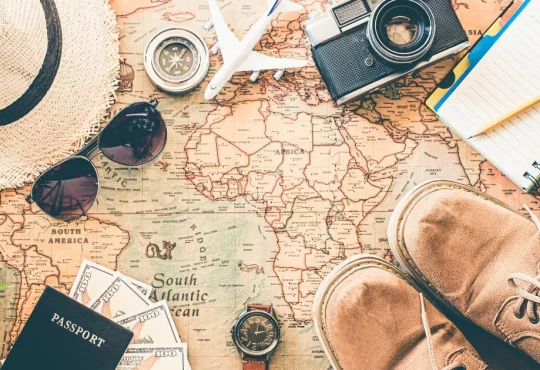Traveling should be enjoyable for everyone, yet wheelchair users often find flying stressful due to concerns over potential damage to their mobility equipment. This can result in extra costs, insurance claims, and the need to navigate interactions with airlines. To help ease these challenges, we’ve gathered comprehensive information to assist wheelchair users in preparing for air travel. Whether understanding airline policies, ensuring equipment safety, or navigating airport procedures, our guide aims to empower travelers with the knowledge needed for a smoother journey to their next destination.
Air Travel Tips for Wheelchair Users: Top 5 Perfect Guide!
Book in Advance:
Wheelchair users must plan when booking air travel. Inform the airline about your wheelchair use and any specific needs when booking. This includes requesting assistance such as wheelchair support from check-in through to the boarding gate, help with boarding, and assistance during flight transfers. By doing so, airlines can make necessary arrangements to ensure your comfort and safety throughout your journey.
Choose Direct Flights:
Opting for direct flights is highly recommended to minimize the number of transfers and potential complications that may arise during travel. When selecting your seat, consider your personal comfort preferences. Whether it’s an aisle seat for easier access to the restroom and movement or a bulkhead seat for extra legroom and space to maneuver, choosing the right seat can significantly enhance your travel experience.
Pack Essentials:
Pack your essential items in your carry-on luggage to ensure they’re easily accessible during the flight. This includes medications, personal care items, and any necessary medical supplies. Keeping these items close ensures you have everything you need to manage your health and comfort throughout the journey.
Check Airport Accessibility:
Before heading to the airport, take the time to research its accessibility features. Check for accessible parking options if needed, and inquire about accessible routes into and out of the terminal. Familiarize yourself with the check-in process for wheelchair users and ask about any specialized services available for passengers with disabilities. Being informed about these details helps streamline your airport experience and ensures you’re well-prepared for your journey.
Preparing for Departure: Airport Procedures
Arrive at the airport with ample time before your flight to accommodate check-in, security screening, and boarding processes. Airlines generally advise arriving at least two hours before domestic and three hours before international flights to ensure a smooth journey.
Navigating Security Checkpoints
- Inform TSA Officers:
Let TSA officers know if you require assistance during the security screening. They are specifically trained to support travelers with disabilities, ensuring you receive the necessary help and accommodations. Whether you need guidance through the metal detectors or require a pat-down screening, communicating your needs will help streamline the process. Their training is designed to make the security experience as smooth and comfortable as possible for all passengers, including those with disabilities.
- Wheelchair Screening:
Ambulatory wheelchair users do not need to transfer out of their wheelchair to pass through metal detectors. Instead, TSA officers can perform a thorough pat-down screening, ensuring the process is respectful and accommodating. This alternative screening method allows wheelchair users to remain in their chairs, avoiding unnecessary discomfort or inconvenience. For more detailed information on this procedure and what to expect, visit the WheelchairTravel.org website, which provides comprehensive resources and guidance for travelers with disabilities.
- Pro Tip:
Apply for TSA PreCheck or Global Entry in the United States to enjoy expedited security screenings and a more convenient airport experience. Although these trusted traveler programs require extensive background checks and a thorough application process, they significantly streamline the security procedures for approved travelers. By enrolling in these programs, you can benefit from shorter lines, a quicker, less invasive security process, and the ability to keep on certain personal items such as shoes and belts during screening. This can make a considerable difference in the ease and comfort of your air travel, particularly for wheelchair users.
Similar programs exist in various countries around the world. Here are some examples:
- Canada: Verified Traveler program
- United Kingdom: Registered Traveller Program
- Germany: EasyPASS
Before traveling internationally, it’s advisable to research and check if your destination country offers a comparable program. Applying for such programs can streamline your travel experience and provide expedited processing at airports abroad.
Preparing Your Wheelchair for Air Travel
- Know Your Wheelchair:
It’s essential to be well-versed in the dimensions and weight of your wheelchair because airline policies can vary significantly regarding the transportation of mobility devices. Understanding these specifics helps ensure that your wheelchair meets the requirements set forth by the airline.
- Battery-Powered and Power-Assisted Devices:
If you use a battery-powered wheelchair or have power-assisted devices attached to your wheelchair, it’s crucial to check and confirm that they comply with the airline’s regulations. This step helps avoid any issues or delays during check-in and boarding.
- Secure Loose Parts:
Before handing over your wheelchair to airline staff, remove any loose parts that could detach during handling. Items like side guards and armrests should be safely stowed in the plane’s closet to prevent them from getting lost or damaged in transit.
- Protective Measures:
Many wheelchair users protect their equipment from rough handling by wrapping it in pipe insulation and electrical tape. This proactive step helps minimize scratches and other damage that could occur as the wheelchair is moved and stored by airline personnel.
- Cushion and Comfort:
Bringing your wheelchair cushion into the cabin ensures comfort and support during the flight. This is particularly important for preventing pressure sores and maintaining comfort throughout the journey.
- Documentation and Identification:
Taking photographs of your wheelchair before checking it in provides valuable documentation of its condition. In case of any damage or loss, these photos serve as proof and simplify the process of filing a claim with the airline.
- Labeling and Contact Information:
To avoid confusion or loss, label your wheelchair and other mobility aids clearly with your name and contact information. This step ensures that if the equipment is misplaced or incorrectly handled, it can be easily identified and returned to you promptly.
- Handling Instructions:
While attaching signs with handling instructions can be beneficial, remember that airline staff may sometimes have the time to read detailed notes. Instead, consider using visual cues or labels like “fragile” to communicate the need to handle your wheelchair carefully.
Following these tips, you can better prepare your wheelchair for air travel, ensuring a smoother and more comfortable journey. Each step protects your mobility equipment and enhances your overall travel experience as a wheelchair user.
In-Flight Essentials
- Priority boarding is valuable for wheelchair users, ensuring ample time to settle into your seat without feeling hurried. This accommodation acknowledges the extra time often required for wheelchair transfers and adjustments.
- Communicate your needs to the flight crew, whether for assistance during the flight or accessing the restroom. They are trained to provide support and ensure your comfort throughout the journey.
- During longer flights, it’s essential to change positions periodically. This practice helps prevent discomfort and potential pressure sores, ensuring you remain comfortable throughout the flight.
- Upon arrival at your destination, the process involves waiting until all other passengers have disembarked. This allows the crew time to retrieve your wheelchair and bring it directly to the gate, facilitating a smooth transition from the aircraft.
Regaining Possession of Your Wheelchair
When you retrieve your wheelchair from airport handlers, it’s crucial to thoroughly inspect it to ensure everything is in proper working order. Take your time to check for any signs of damage or malfunction. If you notice any issues, you must report them immediately to the baggage claim personnel. Although they may be unable to address the issue right at the gate, informing them promptly can start documenting and resolving the problem.
Remember, it’s important not to leave the airport without initiating a formal claim for any damage or issues with your wheelchair. This step is critical for several reasons: it ensures that the airline acknowledges the problem, begins an investigation into the incident, and can provide compensation or repairs as necessary. Even if the damage seems minor, documenting it at the airport ensures you have a record of the incident, making it easier to follow up and seek resolution later.
Filing a claim also helps to hold the airline accountable for the condition of your wheelchair during transport. This process typically involves completing paperwork with details of the damage, providing any photos or documentation you’ve gathered, and obtaining a copy of the claim for your records. By taking these steps promptly, you protect your rights and increase the likelihood of a swift resolution to any issues encountered while traveling with your wheelchair.
Conclusion:
Traveling should be enjoyable for everyone, yet wheelchair users often find flying stressful due to concerns over potential damage to their mobility equipment. To ease these challenges, our guide provides crucial information on preparing for air travel, understanding airline policies, and ensuring equipment safety. By planning, booking assistance, choosing direct flights, and packing essentials, you can enhance your travel experience. Knowing how to secure your wheelchair and handle any issues promptly ensures a smoother journey and empowers wheelchair users to travel confidently.





